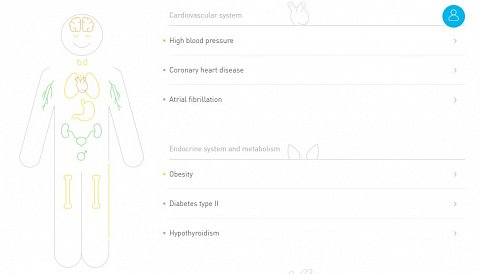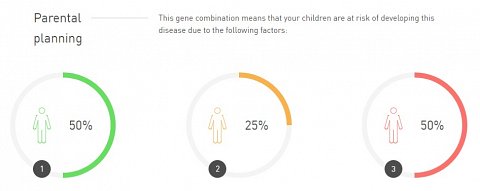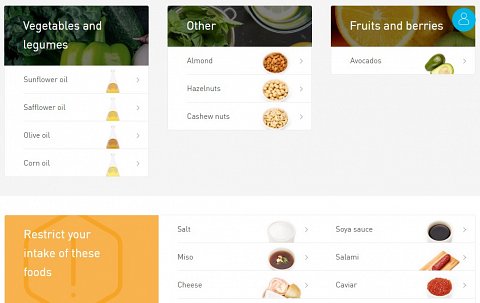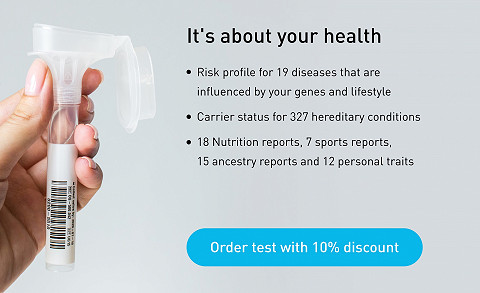-
Atlas DNA Test
review on 1 September 2018
by Craig Macpherson

At a Glance
Summary
The Atlas Biomed DNA Test provided loads of information about my health. I was particularly impressed by the number of diseases and traits screened for, especially in the Carrier Status section. I really enjoyed the Nutrition and Food results and, although I struggled to work out how I could implement all of them, found the recommendations useful.
The fact that my Disease Risks were displayed using an image as well as text was great, and the explanations helped to ensure that I understood the various factors that contributed to my overall risk. I thought the test was superb value for money and I’d recommend it to anyone interested in finding out more about how their DNA might impact their health.
Full Review
Atlas Biomed are a London-based company that recently developed the world’s first DNA and microbiome health platform. Their tests are designed in the hope that customers are empowered to take control of their health, taking preventative rather than reactive measures to protect themselves from disease. The company’s novel approach to maintaining and improving health has already attracted significant media attention, with City AM and The Express among the publications that have featured their tests.
After reading about Atlas Biomed’s innovative approach and impressive ambitions, I was excited to try out their test to find out about my health and ancestry!
Please note that reviews for the health-related aspects of the test can be found here.
Product Expectations
On the Atlas Biomed website, I was greeted with the prominent statement ‘You can change’. As I scrolled down the page, I saw images of the two kits, ‘DNA’ and ‘Microbiome’, each with bullet points explaining their features.
Reading through these, I learnt that the DNA test would provide me with information about a wide range of health and ancestry topics. I would learn about my disease risks and carrier status, how to improve my diet and fitness plan, explore personal traits and even get an insight into my ancestry.
I was impressed with the amount of information I could expect to receive in one test, and although the microbiome test looked interesting, I decided this was enough to start with.
In addition to the details provided on the homepage, there was a section dedicated specifically to the DNA Test that provided further information about it. I learnt that the test would assess 17 disease risks, using both my genetic data and lifestyle information, and would look at 283 conditions that I could potentially pass on to my children. The specific areas of diet and fitness that would be examined were also described, and I was excited to read that I’d receive personalised food recommendations based on my results.
There was also a ‘How it works’ page, which went through each stage of testing, using images of the kit and its contents to illustrate the process.
Ordering Experience
When it came to ordering the test, I clicked one of the ‘Order now’ buttons and was taken straight to a checkout page. I entered my name, address, email and phone number and was pleased to the kit should only take 2-3 days to arrive. However, I was less pleased when I realised that I had to pay an extra £9.99 for shipping.
I entered my card details, to pay using Stripe, but first had to agree to Atlas Biomed’s Terms & Conditions. I’d already seen and been impressed by the privacy information provided on the ‘How it works’ page, which had included the specific type of encryption and security that the company used.
The terms and conditions confirmed these protections. However, I read that Atlas Biomed could use my genetic and self-reported data for research and development of products or services that I would be able to claim no compensation for, which worried me a little. Something else that alarmed me initially was the advice that I consult with a legal professional before sharing my genetic results with anyone, as they could be used against my interests. Once I thought this over though, I realised it was sensible advice to give and appreciated being made aware of the potential risks.
The kit arrived within the estimated time and looked exactly like the one on the website. Registration was simple, as was providing the saliva sample. I was happy to find that return postage had been included in the shipping cost.
The Results
The results arrived within a month, as had been estimated on the website. I received an email to notify me that they were ready and could be viewed via the account I’d set up when registering my kit.
When I logged in, I was taken to a ‘Your Health Profile’ dashboard page (shown below).

The Your Health Profile page.
This served as a really good summary of my results and provided an excellent base from which to explore the different sections.
Results Section: Health
The largest section on this summary dashboard was ‘Health’, which included two sections, ‘Disease risks’ and ‘Carrier status’. I clicked on the Health arrow, which took me to a page that provided a summary of these results, and allowed me to click each condition for more details.
The outcome of each result was displayed using a traffic light colour-coding system, with high-risk conditions coloured red, average in orange/yellow and low risk in green. These were accompanied by an outline of the human body, with organs representing different systems within it, coloured according to the results associated with that area (shown below).

The summary of my Health results.
I thought this was a great way to show the results and it was immediately clear which areas of my body were most and least at risk of disease.
I was concerned to see that my Alzheimer’s disease result was highlighted orange, so clicked to read more. At the top of the page, a risk scale was shown, with a marker indicating where my result put me on it. Beneath this, there was a short explanation that clearly stated I was at an increased risk of the disease, but that if I followed the recommendations they could ‘yield specific results’.
Beneath this, I was given a more specific risk assessment, which had been broken down into disease prevalence and genetic risk. I was pleased to see that the genetic aspect only increased my risk by 0.73% and overall only had a 5.63% increased risk, which seemed a lot less significant than it had initially.
There was also a description of the disease and a table of the genes that had been tested. Each gene was given a plus or minus percentage, and whilst this wasn’t explained, I guessed that it indicated the level of increased or decreased risk associated with it. I noticed that when I hovered my pointer over any of the rows, information about that gene and its link to Alzheimer’s disease was provided.
I was happy to find that I didn’t have any red results that suggested a high personal risk of disease, though looking at my Carrier Status results, I found out that I was a healthy carrier of a mutation associated with a condition called ‘Classical Homocystinuria’. I had never heard of this disease and whilst I was reassured that, as a carrier, I wouldn’t suffer from it myself, it was a bit worrying. Luckily, there was lots of information about the condition. I learnt that it was serious but rare, affecting 1 in 58,000-350,000 new-borns with a range of symptoms. I really appreciated that the medical terms for these symptoms had also been explained in plain English. For example, I found out that ‘megaloblastic anaemia’ meant having too many red blood cells.
I also found the ‘Prenatal Planning’ diagram (shown below) helpful and reassuring.

The Prenatal planning diagram.
This outlined my risks of having a child with this condition, depending on the carrier status of my partner, and it helped to make the concept a lot clearer in my head. I was also relieved to find out that even if I had a child with someone who had the condition, there was still a 50% chance that the baby would be born a healthy carrier.
There was a lot of information about the science and the condition, which was explained in an understandable way. I also found it helpful that the exact mutation associated with being a carrier of this condition had been highlighted in the table of three that had been examined.
In a ‘Recommendations’ section, I was advised to contact a GP or genetic counsellor about my results. I was pleased to find a link to more information, but unfortunately this didn’t include any information about how I might find a genetic counsellor.
Results Section: Nutrition
After this quite heavy section of results, I looked forward to moving on to the more light-hearted ‘Nutrition’ section. These results were set out slightly differently to those Health section, with a summary page that showed the significant results highlighted in blue and exclamation mark. Unlike the previous section, they also provided a text summary of each result rather than using a colour-coding system.
It was therefore immediately clear that the three results I should look at were ‘Glucose Levels’, ‘Vitamin A’ and ‘Iron’. I clicked on the first of these for more information and saw that these pages were formatted in the same way as the Health ones had been. I found out that my result was associated with predisposition to higher levels of glucose. It was interesting to read that this didn’t necessarily mean that I was likely to eat more sugar, but was more to do with the way in which my body processed it. I noticed that the results in this section were based solely on my genetic results, rather than in combination with lifestyle and prevalence.
I was surprised that there weren’t any obvious links from these results to my food recommendations, but found a link to them in the menu on the side, under the heading ‘Foods’ (shown below).

The Foods section.
The recommended foods weren’t as comprehensive as I’d expected them to be, and I thought I’d probably struggle to come up with a meal using them as ingredients.
The foods I was recommended to restrict my intake of were a lot easier and for many (eg. Caviar!), I was pretty sure they’d be easy to cut out of my diet completely. However, as a cheese lover, I was dismayed to see that it had included in this list!
Results Section: Sports
The last health-related section provided information about how my genes might affect my sporting abilities. On the summary page, I saw that results had been highlighted in a similar way to how they’d been in the Nutrition section, but with little medals symbols rather than explanation marks, suggesting that these were areas I was more likely to excel in (shown below).

Some of my Sports results.
The text summaries of the results, also included on this page, confirmed this and I found out that I was predisposed to be better at power/speed type exercises and fast muscle growth. I also found out that I was genetically less prone to developing an inguinal hernia or metabolic myopathy.
The first two of these results seemed pretty self-explanatory, but I wasn’t sure quite what either of the conditions I was less at risk of actually were, so clicked to read more. I was happy to find that there was clear information about the conditions and their connection to DNA, as well as the results for each variant and a link to supporting scientific publications. This was a feature of all the results I had looked at, which increased the trust I had in the results and made it easy to further explore them.
Summary
The Atlas Biomed DNA Test provided loads of information about my health. I was particularly impressed by the number of diseases and traits screened for, especially in the Carrier Status section. I really enjoyed the Nutrition and Food results and, although I struggled to work out how I could implement all of them, found the recommendations useful.
The fact that my Disease Risks were displayed using an image as well as text was great, and the explanations helped to ensure that I understood the various factors that contributed to my overall risk. Overall, I thought the test was superb value for money and I’d recommend it to anyone interested in finding out more about how their DNA might impact their health.


